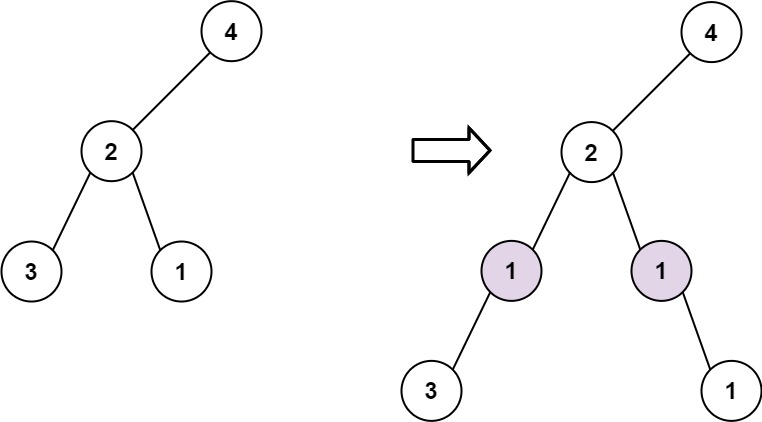Table of Contents
Description Add One Row to Tree
Given the root of a binary tree and two integers val and depth, add a row of nodes with value val at the given depth depth.
Note that the root node is at depth 1.
The adding rule is:
- Given the integer
depth, for each not null tree nodecurat the depthdepth - 1, create two tree nodes with valuevalascur‘s left subtree root and right subtree root. cur‘s original left subtree should be the left subtree of the new left subtree root.cur‘s original right subtree should be the right subtree of the new right subtree root.- If
depth == 1that means there is no depthdepth - 1at all, then create a tree node with valuevalas the new root of the whole original tree, and the original tree is the new root’s left subtree.
Example 1

|
1 2 |
<strong>Input:</strong> root = [4,2,6,3,1,5], val = 1, depth = 2 <strong>Output:</strong> [4,1,1,2,null,null,6,3,1,5] |
Example 2

|
1 2 |
<strong>Input:</strong> root = [4,2,null,3,1], val = 1, depth = 3 <strong>Output:</strong> [4,2,null,1,1,3,null,null,1] |
Constraints
- The number of nodes in the tree is in the range
[1, 104]. - The depth of the tree is in the range
[1, 104]. -100 <= Node.val <= 100-105 <= val <= 1051 <= depth <= the depth of tree + 1
Solution
|
1 2 3 4 5 6 7 8 9 10 11 12 13 14 15 16 17 18 19 20 21 22 23 24 25 26 27 28 29 30 31 32 33 34 35 36 37 38 39 40 41 42 43 44 45 46 47 48 49 50 51 52 53 54 55 |
/** * Definition for a binary tree node. * public class TreeNode { * int val; * TreeNode left; * TreeNode right; * TreeNode(int x) { val = x; } * } */ public class Solution { public TreeNode addOneRow(TreeNode root, int v, int d) { if(d==1) { TreeNode temp = new TreeNode(v); temp.left = root; return temp; } Queue<TreeNode> next = new LinkedList<>(); Queue<TreeNode> curr; next.offer(root); int depth = 1; while(!next.isEmpty()) { curr = next ; next = new LinkedList<>(); while(!curr.isEmpty()) { TreeNode temp = curr.poll(); if(depth==d-1){ TreeNode newLeft = new TreeNode(v); TreeNode l = temp.left; newLeft.left = l; temp.left = newLeft; TreeNode newRight = new TreeNode(v); TreeNode r = temp.right; newRight.right = r; temp.right = newRight; } else { if(temp.left!=null){ next.offer(temp.left); } if(temp.right!=null){ next.offer(temp.right); } } } if(depth==d-1){ return root; } depth++; } return root; } } |
Time Complexity
O(n), where n is the number of nodes in a binary tree
Space Complexity
O(n), at any point we would be storing the nodes at two adjacent depths at most in a binary tree